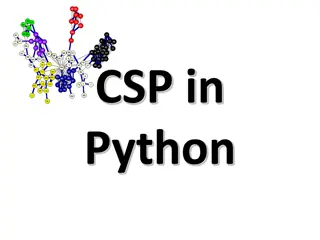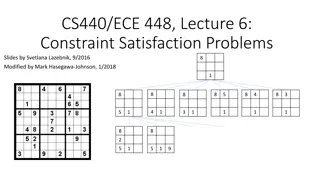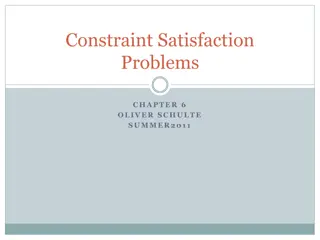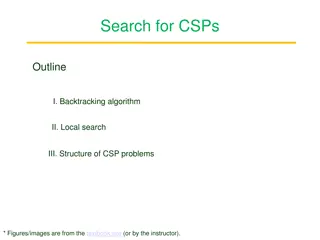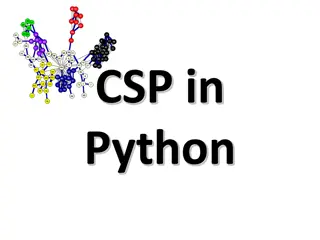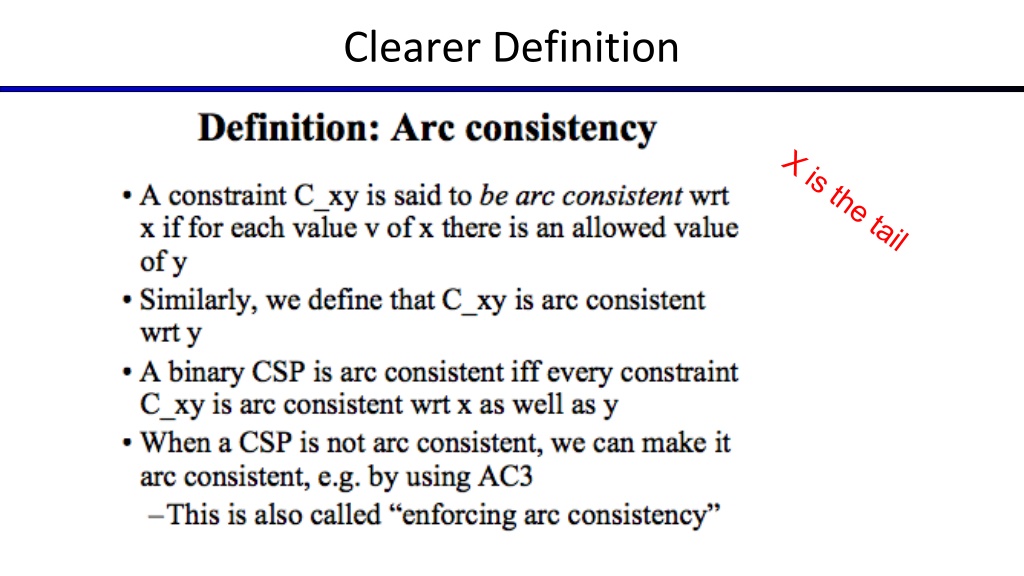
Chess CSP Problem: Constraints and Solutions
Explore the application of Constraint Satisfaction Problems (CSP) in solving the 4-queens chess problem through variables, constraints, and methods like forward checking and AC3. Understand the implications of variable assignments, consistency, and queue management in making the CSP arc consistent for optimal solutions.
Uploaded on | 0 Views
Download Presentation

Please find below an Image/Link to download the presentation.
The content on the website is provided AS IS for your information and personal use only. It may not be sold, licensed, or shared on other websites without obtaining consent from the author. If you encounter any issues during the download, it is possible that the publisher has removed the file from their server.
You are allowed to download the files provided on this website for personal or commercial use, subject to the condition that they are used lawfully. All files are the property of their respective owners.
The content on the website is provided AS IS for your information and personal use only. It may not be sold, licensed, or shared on other websites without obtaining consent from the author.
E N D
Presentation Transcript
Chess as a CSP Let s define the 4-queens problem as a CSP with the variable Xi denoting the position (row) of the queen on column i. X1 = 1 X1 = 2 Remember the constraints: two queens attack each other when the are in the same row, the same column or on the same diagonal. We want to place n=4 queens on the board so no queen is attacking another.
CSP Challenge Question 1 Suppose we set X1 = 1 Show the effect of forward checking on the domains of the remaining variables (I suggest crossing off values in the lists below:) X1 = 1 Domain X2 = {1, 2, 3, 4} Domain X3 = {1, 2, 3, 4} Domain X4 = {1, 2, 3, 4}
Answer 1 Forward checking will delete values from the domains of all other variables, as shown
Question 2 Is this CSP now arc consistent? (for the purposes of this question assume that there is one constraint between each pair of queens that rules out all attacks)
Answer 2 No, the constraint between X2 and X3 is not consistent with respect to X2 There exists a value in the domain of X2 (specifically X2=3) such that NO value for X3 will work. Furthermore, the constraint between X4 and X3 is not consistent with respect to X4, because X4=3 also leaves X3 with no legal values
Question 3 Simulate the behavior of AC3 to make the CSP arc consistent First subquestion, what goes on the queue?
Answer 4 For each pair of variables, you need to put a directed constraint. I ll write X2 X3 to mean the constraint wrt X2 (ie X2 is the tail) For this example, let s ignore constraints with X1 because those constraints are consistent (as a result of forward checking) and can t become inconsistent because we ve chose a single value for X1. So the queue might be <X2 X3, X2 X4, X3 X2, X3 X4, X4 X2, X4 X3> We ve already established that X2 X3 is inconsistent. What does AC-3 do to fix this?
Answer 5 AC-3 deletes from the domain of X2.. So now Domain(X2) = {4} AC-3 also adds some more constraints onto the queue, X3 X2 and X4 X2, but since they are already there there is no change. So the queue is <X2 X4, X3 X2, X3 X4, X4 X2, X4 X3> Is X2 X4 consistent?
Answer 6 Yep. Now the queue is <X3 X2, X3 X4, X4 X2, X4 X3> Is X3 X2 consistent?
Answer 7 Nope. We need to delete X3=4. That means we need to add some stuff to the queue. So what s the queue become?
Answer 8 We add X2 X3 and X4 X3 but the latter was already there so we get <X3 X4, X4 X2, X4 X3, X2 X3> Now what happens when we process the next constraint?
Answer 9 X3 X4 is inconsistent so we need to remove X3=2, but now X3 s domain is empty, which means that the CSP is unsolvable. So the very first decision to Assign X1=1 was a mistake. In fact, following the pseudocode, AC3 will keep running and remove some more stuff a bit pointless. But I ll stop here.
Part II Tree structured CSPs E A B D F C Let s color this!
Tree-Structured CSPs Algorithm for tree-structured CSPs: 1. Order: Choose a root variable, order variables so that parents precede children 2. Remove backward: For i = n : 2, apply RemoveInconsistent(Parent(Xi),Xi) 3. Assign forward: For i = 1 : n, assign Xi consistently with Parent(Xi)
Tree-Structured CSPs Algorithm for tree-structured CSPs: 1. Order: Choose a root variable, order variables so that parents precede children My choice to start with A as the root is arbitrary could have started with anything else. It also doesn t matter if B comes before C in the ordering etc.
Question 10 Algorithm for tree-structured CSPs: 1. Order: Choose a root variable, order variables so that parents precede children 2. Remove backward: For i = n : 2, apply RemoveInconsistent(Parent(Xi),Xi) Suppose that the initial legal colors are as I show above Simulate step 2 of the algorithm (I suggest cross off colors in the diagram above)
Answer 10 Algorithm for tree-structured CSPs: 1. Order: Choose a root variable, order variables so that parents precede children 2. Remove backward: For i = n : 2, apply RemoveInconsistent(Parent(Xi),Xi) When processing D F, we need to remove blue from the domain of D What about when we process D E?
Answer 11 Algorithm for tree-structured CSPs: 1. Order: Choose a root variable, order variables so that parents precede children 2. Remove backward: For i = n : 2, apply RemoveInconsistent(Parent(Xi),Xi) When processing D E, we don t do anything. We would only remove something from the parent, D, but red is consistent, because we can make E green. So we just leave it as is. What about B D?
Answer 12 Algorithm for tree-structured CSPs: 1. Order: Choose a root variable, order variables so that parents precede children 2. Remove backward: For i = n : 2, apply RemoveInconsistent(Parent(Xi),Xi) When processing B C, we don t do anything. What about A B?
Answer 13 Algorithm for tree-structured CSPs: 1. Order: Choose a root variable, order variables so that parents precede children 2. Remove backward: For i = n : 2, apply RemoveInconsistent(Parent(Xi),Xi) 3. Assign forward: For i = 1 : n, assign Xi consistently with Parent(Xi) Right, we delete blue from A. Now simulate step 3. Any choice for A is ok. B will be blue. C can be red or green. D is red, E will be green It all works!!







